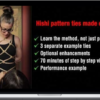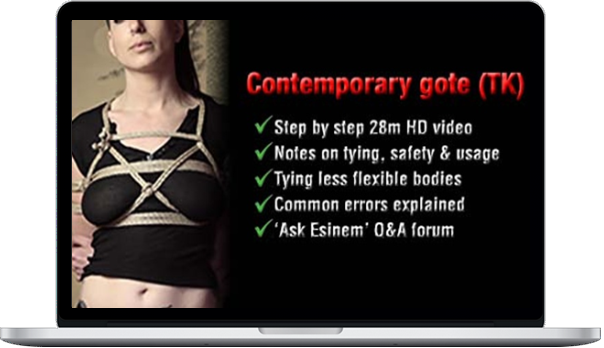Bruce Esinem – Contemporary Gote (2 & 3-Rope Takate kote)
$20.00 $10.00
»Delivery: Within 21 days
Description
Bruce Esinem – Contemporary Gote (2 & 3-Rope Takate Kote)
Description Of Contemporary Gote
An in-depth tutorial on variants of the takate-kote
Contemporary gote (2-TK and 3-TK aka takate-kote)
This tutorial covers the main features of some of the current derivatives of Akechi Denki’s iconic gote (aka takate kote, TK, 2 & 3-TK) popularised by Nawashi Kanna, Osada Steve and Kinoko Hajime.
It is an in-depth examination of a generic gote which identifies the key features and engineering principles common to this family of ties. It explains techniques passed on by direct tuition by Kinoko Hajime and Osada Steve, and other masters of the art, combined with years of practice teaching, performing and playing with rope.
Each step of tying is covered in a 2-camera HD video shot from multiple angles with close-ups so you don’t miss a thing. Not only that but each step is described as it happens and there’s a transcript with copious notes.
I have also added a video of the untying with no cuts so you can learn from seeing flow in action, plus by Kinoko, Steve and Osada ryu instructors. Of course safety is paramount, so there are articles on common mistakes and some of the most detailed information on avoiding nerve injury available.
There is now an additional 20 minute section on tying less flexible people. This gives two examples. The first is a modification of the standard gote for those who cannot get their arms into the classic position. The second is something I devised on the fly to accommodate a problem with the model’s shoulder. Strictly speaking it is a half-gote as only one arm is behind, the other is in front, as one might have an arm in a sling, hence my name ‘broken arm gote’. These two ties illustrate how standard ‘ingredients’ can be used to modify ‘recipes’ so long as the structurasl rules are followed.
I can guarantee you will be very surprised to discover what you don’t know about this core tie, even if you think you know how to tie it.
About Bruce Esinem
Esinem is a shibari artist who has regularly appeared at UK and international events such as Pride, Torture Garden, Erotica, Rubber Ball, Wasteland, Boundcon, Nuit Demonia and recently represented the UK at Japan’s first international kinbaku event, Toubaku. He is also known for his teaching both in the UK and internationally and was co-organiser of the London Festival of the Art of Japanese Bondage and BOUND, Europe’s premier monthly shibari event.
Over the years, he has been improving his skills with the help some of their best known and respected Jpanese kinbakushi, Arisue Go, Osada Steve, Kinoko Hajime, Kazami Ranki and, grand master of newaza, Yukimura Haruki. Whilst drawing from classical methods, his style is distinctive and epitomizes the art of communicating with rope, often departing from the typical serenity of shibari shows and flying in the face of tradition to produce some striking and unusual performances.
In addition, he has worked on various videos, e.g. Primal Scream’s 2013, artistic collaborations and photo shoots both on and off camera. He has been involved in projects providing inspiration for Tom Ford’s 2013 collection and, Raqib Shaw, an acclaimed artist who has exhibited at the Tate, Metropolitan and White Cube galleries.
He contributed to Rope, Bondage & Power, edited by Lee Harrington and has been involved with a number of documentaries on kinbaku. He is also author of the first English language tutorial DVDs: ‘Japanese Rope Bondage: Tying people, not parcels’ .
More courses from the same author: Bruce Esinem
Delivery Policy
When will I receive my course?
You will receive a link to download your course immediately or within 1 to 21 days. It depends on the product you buy, so please read the short description of the product carefully before making a purchase.
How is my course delivered?
We share courses through Google Drive, so once your order is complete, you'll receive an invitation to view the course in your email.
To avoid any delay in delivery, please provide a Google mail and enter your email address correctly in the Checkout Page.
In case you submit a wrong email address, please contact us to resend the course to the correct email.
How do I check status of my order?
Please log in to DatingCourse account then go to Order Page. You will find all your orders includes number, date, status and total price.
If the status is Processing: Your course is being uploaded. Please be patient and wait for us to complete your order. If your order has multiple courses and one of them has not been updated with the download link, the status of the order is also Processing.
If the status is Completed: Your course is ready for immediate download. Click "VIEW" to view details and download the course.
Where can I find my course?
Once your order is complete, a link to download the course will automatically be sent to your email.
You can also get the download link by logging into your DatingCourse account then going to Downloads Page.
You may also like:
- See more 2 Girls Teach Sex courses
- See more 60 Years of Challenge courses
- See more Adam Armstrong courses
- See more Adam Gilad courses
- See more Adam Lyons courses
- See more Arash Dibazar courses
- See more Bobby Rio courses
- See more Carlos Xuma courses
- See more David Deangelo courses
- See more David Shade courses
- See more David Snyder courses
- See more David Tian courses
- See more David Wygant courses
- See more Dean Cortez courses
- See more Derek Rake courses
- See more FortWorthPlayboy courses
- See more Gabrielle Moore courses
- See more Helena Nista courses
- See more James Marshall courses
- See more Jason Capital courses
- See more Jean Marie Corda courses
- See more Joe Lampton courses
- See more Jon Sinn courses
- See more Lloyd Lester courses
- See more Love Systems courses
- See more Marisa Peer courses
- See more Matt Cook courses
- See more Matt Granger courses
- See more Nick Krauser courses
- See more Pleasure Mechanics courses
- See more Ross Jeffries courses
- See more Talmadge Harper courses
- See more The Modern Man courses
- See more Tom Torero courses
Related products
Total sold: 3
Total sold: 110
Total sold: 4










